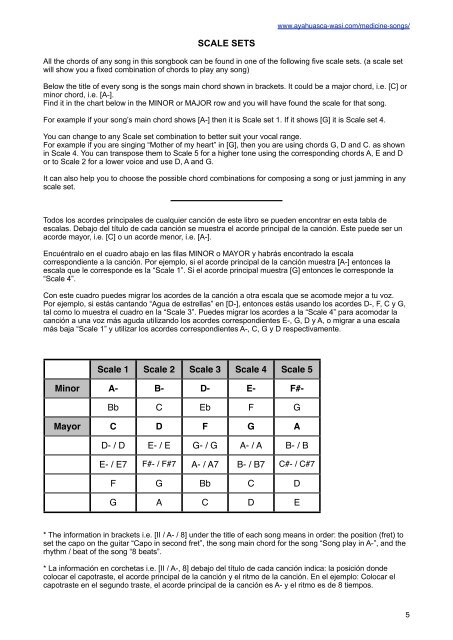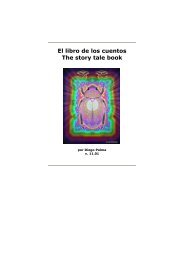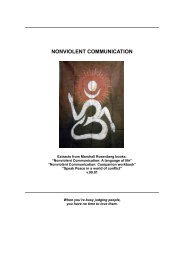You also want an ePaper? Increase the reach of your titles
YUMPU automatically turns print PDFs into web optimized ePapers that Google loves.
SCALE SETS<br />
All the chords of any song in this <strong>songbook</strong> can be found in one of the following five scale sets. (a scale set<br />
will show you a fixed combination of chords to play any song)<br />
Below the title of every song is the songs main chord shown in brackets. It could be a major chord, i.e. [C] or<br />
minor chord, i.e. [A-].<br />
Find it in the chart below in the MINOR or MAJOR row and you will have found the scale for that song.<br />
For example if your song’s main chord shows [A-] then it is Scale set 1. If it shows [G] it is Scale set 4.<br />
You can change to any Scale set combination to better suit your vocal range.<br />
For example if you are singing “Mother of my heart” in [G], then you are using chords G, D and C. as shown<br />
in Scale 4. You can transpose them to Scale 5 for a higher tone using the corresponding chords A, E and D<br />
or to Scale 2 for a lower voice and use D, A and G.<br />
It can also help you to choose the possible chord combinations for composing a song or just jamming in any<br />
scale set.<br />
Todos los acordes principales de cualquier canción de este libro se pueden encontrar en esta tabla de<br />
escalas. Debajo del título de cada canción se muestra el acorde principal de la canción. Este puede ser un<br />
acorde mayor, i.e. [C] o un acorde menor, i.e. [A-].<br />
Encuéntralo en el cuadro abajo en las filas MINOR o MAYOR y habrás encontrado la escala<br />
correspondiente a la canción. Por ejemplo, si el acorde principal de la canción muestra [A-] entonces la<br />
escala que le corresponde es la “Scale 1”. Si el acorde principal muestra [G] entonces le corresponde la<br />
“Scale 4”.<br />
Con este cuadro puedes migrar los acordes de la canción a otra escala que se acomode mejor a tu voz.<br />
Por ejemplo, si estás cantando “Agua de estrellas” en [D-], entonces estás usando los acordes D-, F, C y G,<br />
tal como lo muestra el cuadro en la “Scale 3”. Puedes migrar los acordes a la “Scale 4” para acomodar la<br />
canción a una voz más aguda utilizando los acordes correspondientes E-, G, D y A, o migrar a una escala<br />
más baja “Scale 1” y utilizar los acordes correspondientes A-, C, G y D respectivamente.<br />
Scale 1 Scale 2 Scale 3 Scale 4 Scale 5<br />
Minor A- B- D- E- F#-<br />
Bb C Eb F G<br />
Mayor C D F G A<br />
D- / D E- / E G- / G A- / A B- / B<br />
E- / E7 F#- / F#7 A- / A7 B- / B7 C#- / C#7<br />
F G Bb C D<br />
G A C D E<br />
www.ayahuasca-wasi.com/medicine-songs/<br />
* The information in brackets i.e. [II / A- / 8] under the title of each song means in order: the position (fret) to<br />
set the capo on the guitar “Capo in second fret”, the song main chord for the song “Song play in A-”, and the<br />
rhythm / beat of the song “8 beats”.<br />
* La información en corchetas i.e. [II / A-, 8] debajo del título de cada canción indica: la posición donde<br />
colocar el capotraste, el acorde principal de la canción y el ritmo de la canción. En el ejemplo: Colocar el<br />
capotraste en el segundo traste, el acorde principal de la canción es A- y el ritmo es de 8 tiempos.<br />
5





